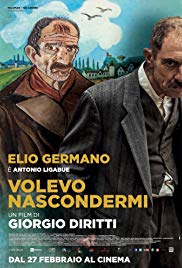
HIDDEN AWAY/ VOLEVO NASCONDERMI
Already in 1978, Italian television RAI had produced a docudrama on the life and work of the Italian artist of the early 20th century, Antonio Ligabue.
RAI has now collaborated with this feature biography of the artist, a strange man with an unusual talent, recognised in his own time and a celebrity in later times.
At first glance, and afterwards, Ligabue seems an unlikely artist and celebrity. In early years he lived in Switzerland, in difficult conditions, harshly dealt with by authorities and family. He grows up somewhat disfigured, especially in his face, and with mental limitations. He spends some time being interrogated and in institutions.
On his return to Italy, he lives on the fringes but eventually does some sketches, moulds some clay into toys, is befriended by some children, rescued by a sculptor who makes gravestones and cared for by his mother.
Surprisingly, from an outside point of view, Ligabue becomes more and more accepted, with his sketches, with the clay toys, with his beginning to paint, simple pictures, more elaborate pictures, murals…
And there is wide interest, buyers and investors – with the result that he becomes much more accepted in his town, has money and is able to indulge a desire for motor bikes, eventually cars with chauffeurs. He becomes a celebrity, very conscious that he is an artist.
Which means that this film is an exploration, portrait and tribute.
1. The life of the artist? Reputation in Italy? Outside Italy?
2. The recreation of the period, 1920s and 1930s? Migrant life in Switzerland? The contrast with Italy, the North, the village, living in poverty, the establishment? The musical score?
3. Anton, Italian child in Switzerland, his appearance, being bullied, in the bag, the role of his parents? Going into the water? The effect on him psychologically? His physical growth? His face, teeth? His behaviour? His time in institutions, being interviewed, the treatment?
4. Going to Italy, his being looked down on, the lonely life? The sculptor and his friendship? Working with gravestones? His mother, care and concern? Seeing something in his potential?
5. The young man and his art, the sketches, his moulds, the toys, the response of the children and their parents, the little girl who was considerate, the impact of her death? His pain?
6. Finding an audience, their puzzling, his range of work, the range of moulds, animals and creativity, his being upset, throwing them into the river? His beginning to paint, the initial paintings, carrying them around the town, selling them in the street?
7. The recognition, the increased range of paintings, the establishment, the increasing number of buyers? Painting frescoes on the wall, painting over them?
8. His liking his reputation as an artist, changing him, his personality and style? Winning the medal?
9. The range of friends, the locals, in the bars, at the funeral company, his driver?
10. His interest in motorbikes, righting? Buying them?
11. The transition to cars, his style, pride in the cars? The friendship with the drivers?
12. His reputation in his lifetime, afterwards?
13. The film as a portrait and as a tribute?